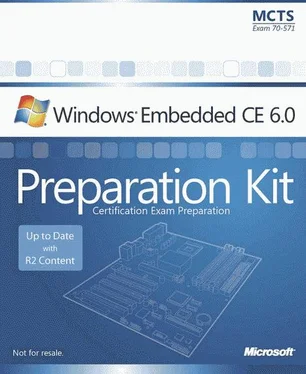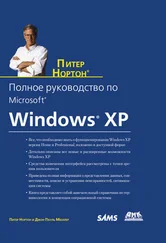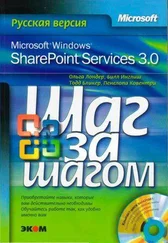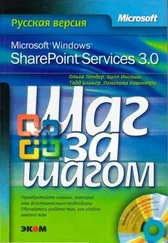Nicolas Besson - Microsoft Windows Embedded CE 6.0 Exam Preparation Kit
Здесь есть возможность читать онлайн «Nicolas Besson - Microsoft Windows Embedded CE 6.0 Exam Preparation Kit» весь текст электронной книги совершенно бесплатно (целиком полную версию без сокращений). В некоторых случаях можно слушать аудио, скачать через торрент в формате fb2 и присутствует краткое содержание. Город: Redmond, Год выпуска: 2008, Издательство: Microsoft, Жанр: Руководства, ОС и Сети, Программы, на английском языке. Описание произведения, (предисловие) а так же отзывы посетителей доступны на портале библиотеки ЛибКат.
- Название:Microsoft Windows Embedded CE 6.0 Exam Preparation Kit
- Автор:
- Издательство:Microsoft
- Жанр:
- Год:2008
- Город:Redmond
- ISBN:нет данных
- Рейтинг книги:5 / 5. Голосов: 1
-
Избранное:Добавить в избранное
- Отзывы:
-
Ваша оценка:
- 100
- 1
- 2
- 3
- 4
- 5
Microsoft Windows Embedded CE 6.0 Exam Preparation Kit: краткое содержание, описание и аннотация
Предлагаем к чтению аннотацию, описание, краткое содержание или предисловие (зависит от того, что написал сам автор книги «Microsoft Windows Embedded CE 6.0 Exam Preparation Kit»). Если вы не нашли необходимую информацию о книге — напишите в комментариях, мы постараемся отыскать её.
Microsoft Windows Embedded CE 6.0 Exam Preparation Kit — читать онлайн бесплатно полную книгу (весь текст) целиком
Ниже представлен текст книги, разбитый по страницам. Система сохранения места последней прочитанной страницы, позволяет с удобством читать онлайн бесплатно книгу «Microsoft Windows Embedded CE 6.0 Exam Preparation Kit», без необходимости каждый раз заново искать на чём Вы остановились. Поставьте закладку, и сможете в любой момент перейти на страницу, на которой закончили чтение.
Интервал:
Закладка:
Exception Handling<\/p> <\/div>
Another important aspect that should not be ignored in asynchronous buffer access scenarios revolves around the possibility that embedded pointers might not point to valid memory addresses. For example, an application can pass a pointer to a driver that refers to an unallocated or reserved memory region, or it could asynchronously free the buffer. To ensure a reliable system and prevent memory leaks, you should enclose buffer-access code in a __try frame and any cleanup code to free memory allocations in a __finally block or an exception handler. For more information about exception handling, see Chapter 3, "Performing System Programming."<\/p>
Lesson Summary<\/p> <\/div>
Windows Embedded CE 6.0 facilitates inter-process communication between applications and device drivers through kernel features and marshaling helper functions that hide most of the complexities from driver developers. For parameter pointers, the kernel performs all checks and pointer marshaling automatically. Only embedded pointers require extra care because the kernel cannot evaluate the content of application buffers passed to a driver. Validating and marshaling an embedded pointer in a synchronous access scenario involves a straightforward call to CeOpenCallerBuffer. Asynchronous access scenarios, however, require an additional call to CeAllocAsynchronousBuffer to marshal the pointer one more time. To ensure that your driver does not introduce system vulnerabilities, make sure you handle buffers correctly, create a secure copy of the buffer content so that callers cannot manipulate the values, and do not use pointers or buffer size values in the caller's buffer after they have been marshaled. Never store marshaled pointers or other variables required for driver processing in the caller's buffer.<\/p>
Lesson 7: Enhancing Driver Portability<\/p> <\/div>
Device drivers help to increase the flexibility and portability of the operating system. Ideally, they require no code changes to run on different target devices with varying communication requirements. There are several relatively straightforward techniques that you can use to make your drivers portable and reusable. One common approach is to maintain configuration settings in the registry instead of hardcoding the parameters into the OAL or the driver. Windows Embedded CE also supports a layered architecture based on MDD and PDD that you can leverage in your device driver design, and there are further techniques that you can use to implement drivers in a bus-agnostic way to support peripheral devices regardless of the bus type to which they are connected.<\/p>
After this lesson, you will be able to:<\/strong> <\/p>
■ Describe how to use registry settings to increase the portability and reusability of a device driver.<\/p>
■ Implement a device driver in a bus-agnostic way.<\/p>
Estimated lesson time: 15 minutes.<\/strong> <\/p> <\/cite>
Accessing Registry Settings in a Driver<\/p> <\/div>
To increase the portability and reusability of a device driver, you can configure registry entries, which you should add to the driver's registry subkey. For example, you can define I/O-mapped memory addresses or settings for installable ISRs that the device driver loads dynamically. To access the entries in a device driver's registry key, the driver has to identify where its own settings are located. This is not necessarily the HKEY_LOCAL_MACHINE\Drivers\BuiltIn key. However, the correct path information is available in the Key value that you can find under the HKEY_LOCAL_MACHINE\Drivers\Active key in the loaded driver's subkey. Device Manager passes the path to the driver's Drivers\Active subkey to the XXX_Init function in the LPCTSTR pContext parameter. The device driver can then use this LPCTSTR value in a call to OpenDeviceKey to obtain a handle to the device's registry key. It is not necessary to read the Key values from the driver's Drivers\Active subkey directly. The handle returned by OpenDeviceKey points to the driver's registry key, which you can use like any other registry handle. Most importantly, do not forget to close the handle when it is no longer needed.<\/p>
The XXX_Init function is the best place to determine all configuration settings for a driver defined in the registry. Rather than accessing the registry repeatedly in subsequent stream function calls, it is good practice to store the configuration information in the device context created and returned to Device Manager in response to the XXX_Init call.<\/p> <\/cite>
Interrupt-Related Registry Settings<\/p> <\/div>
If your device driver must load an installable ISR for a device and you want to increase the portability of your code, you can register the ISR handler, IRQ, and SYSINTR values in registry keys, read these values from the registry when initializing the driver, verify that the IRQ and SYSINTR values are valid, and then install the specified ISR by using the LoadIntChainHandler function.<\/p>
Table 6-9 lists the registry entries that you can configure for this purpose. By calling the DDKReg_GetIsrInfo function, you can then read these values and pass them to the LoadIntChainHandler function dynamically. For more information about interrupt handing in device drivers, see Lesson 4, "Implementing an Interrupt Mechanism in a Device Driver," earlier in this chapter.<\/p>
Table 6-9 Interrupt-related registry entries for device drivers<\/strong> <\/p>
| Registry Entry<\/th> | Type<\/th> | Description<\/th> <\/tr> | |||||||||||||||
|---|---|---|---|---|---|---|---|---|---|---|---|---|---|---|---|---|---|
| IRQ<\/td> | REG_DWORD<\/td> | Specifies the IRQ used to request a SYSINTR for setting up an IST within the driver.<\/td> <\/tr> | |||||||||||||||
| SYSINTR<\/td> | REG_DWORD<\/td> | Specifies a SYSINTR value to use for setting up an IST within the driver.<\/td> <\/tr> | |||||||||||||||
| IsrDll<\/td> | REG_SZ<\/td> | The filename of the DLL containing the installable ISR.<\/td> <\/tr> | |||||||||||||||
| IsrHandler<\/td> | REG_SZ<\/td> | Specifies the entry point for the installable ISR that the specified DLL exposes.<\/td> <\/tr> <\/table>
Memory-Related Registry Settings<\/p> <\/div> Memory-related registry values enable you to configure a device through the registry. Table 6-10 lists the memory-related registry information that a driver can obtain in a DDKWINDOWINFO structure by calling DDKReg_GetWindowInfo. By using the BusTransBusAddrToVirtual function, you can map the bus addresses of memory-mapped windows to physical system addresses you can then translate into virtual addresses by using MnMapIoSpace.<\/p> Table 6-10 Memory-related registry entries for device drivers<\/strong> <\/p>
|
Интервал:
Закладка:
Похожие книги на «Microsoft Windows Embedded CE 6.0 Exam Preparation Kit»
Представляем Вашему вниманию похожие книги на «Microsoft Windows Embedded CE 6.0 Exam Preparation Kit» списком для выбора. Мы отобрали схожую по названию и смыслу литературу в надежде предоставить читателям больше вариантов отыскать новые, интересные, ещё непрочитанные произведения.
Обсуждение, отзывы о книге «Microsoft Windows Embedded CE 6.0 Exam Preparation Kit» и просто собственные мнения читателей. Оставьте ваши комментарии, напишите, что Вы думаете о произведении, его смысле или главных героях. Укажите что конкретно понравилось, а что нет, и почему Вы так считаете.








